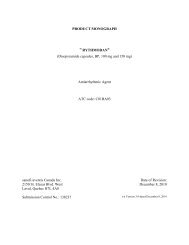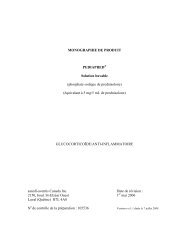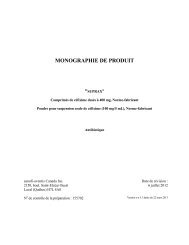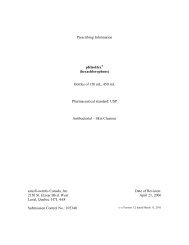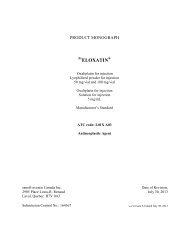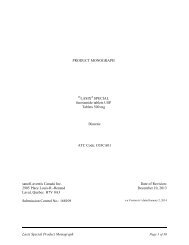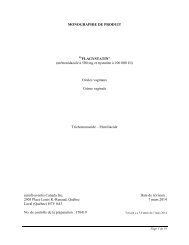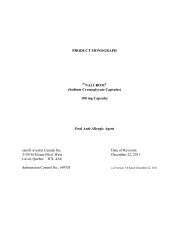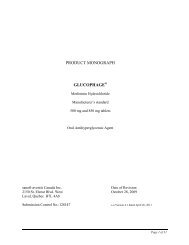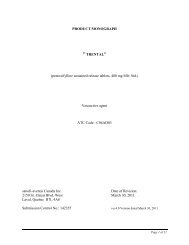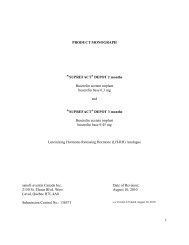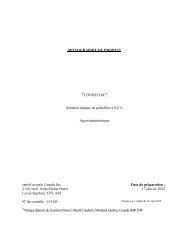Eligard® product monograph - Sanofi Canada
Eligard® product monograph - Sanofi Canada
Eligard® product monograph - Sanofi Canada
- No tags were found...
You also want an ePaper? Increase the reach of your titles
YUMPU automatically turns print PDFs into web optimized ePapers that Google loves.
PRODUCT MONOGRAPHPr ELIGARD ®(Leuprolide acetate for injection)7.5 mg [1-Month]22.5 mg [3-Month]30 mg [4-Month] &(Leuprolide acetate for injectable suspension)45 mg [6-Month]THERAPEUTIC CLASSIFICATIONLuteinizing Hormone-Releasing Hormone Analogsanofi-aventis <strong>Canada</strong> Inc.2150 St. Elzear Blvd. WestLaval, Quebec H7L 4A8Date of Revision:May 31, 2011Submission Control No.: 143721 s-a Version 9.2 dated February 1, 2012Page 1 of 47
Table of ContentsPART I: HEALTH PROFESSIONAL INFORMATION........................................................... 3SUMMARY PRODUCT INFORMATION ......................................................................... 3INDICATIONS AND CLINICAL USE............................................................................... 3CONTRAINDICATIONS .................................................................................................... 4WARNINGS AND PRECAUTIONS................................................................................... 4ADVERSE REACTIONS..................................................................................................... 8DRUG INTERACTIONS ................................................................................................... 11DOSAGE AND ADMINISTRATION............................................................................... 12OVERDOSAGE ................................................................................................................. 24ACTION AND CLINICAL PHARMACOLOGY ............................................................. 24STORAGE AND STABILITY........................................................................................... 29SPECIAL HANDLING INSTRUCTIONS ........................................................................ 29DOSAGE FORMS, COMPOSITION AND PACKAGING .............................................. 29PART II: SCIENTIFIC INFORMATION ................................................................................. 33PHARMACEUTICAL INFORMATION........................................................................... 33CLINICAL TRIALS........................................................................................................... 34DETAILED PHARMACOLOGY...................................................................................... 38MICROBIOLOGY ............................................................................................................. 39TOXICOLOGY .................................................................................................................. 39REFERENCES ................................................................................................................... 43PART III: CONSUMER INFORMATION................................................................................ 45Page 2 of 47
Pr ELIGARD ®(Leuprolide acetate for injection / Leuprolide acetate for injectable suspension)PART I: HEALTH PROFESSIONAL INFORMATIONSUMMARY PRODUCT INFORMATIONRoute ofAdministrationSubcutaneousinjectionDosage Form / StrengthLyophilised powder for injection ( solution after constitutedwith ATRIGEL ®1 polymer system)• 7.5 mg [1-Month] (10.2 mg/BD syringe or10.6 mg/Schott syringe to deliver 7.5 mg leuprolideacetate)• 22.5 mg [3-Month] (28.2 mg/BD syringe or29.2 mg/Schott syringe to deliver 22.5 mg leuprolideacetate)• 30 mg [4-Month] (35.8 mg/BD syringe or37.2 mg/Schott syringe to deliver 30 mg leuprolideacetate)Lyophilised power for injection ( suspension afterconstituted with ATRIGEL ® polymer system)• 45 mg [6-Month] (58.2 mg/BD syringe or59.2 mg/Schott syringe to deliver 45 mg leuprolideacetate)Clinically RelevantNonmedicinal IngredientsN-methyl-2-pyrrolidonePoly (DL-lactide-co-glycolide)INDICATIONS AND CLINICAL USEELIGARD (leuprolide acetate) is indicated for the palliative treatment of advanced prostatecancer (stage D2).ELIGARD should be administered by a health care professional.Geriatrics (> 70 years of age):The majority (> 70%) of the patients studied in the clinical trials for ELIGARD were 70 yearsand older (See CLINICAL TRIALS).Pediatrics (< 12 years of age):The safety and effectiveness of ELIGARD in pediatric patients have not been established (SeeWARNINGS AND PRECAUTIONS).1ATRIGEL ® is a registered trade mark of TOLMAR Therapeutics, Inc.Page 3 of 47
CONTRAINDICATIONSELIGARD is contraindicated in patients with hypersensitivity to Luteinizing Hormone-ReleasingHormone (LH-RH), LH-RH analogs or any of the components of ELIGARD. Anaphylacticreactions to synthetic LH-RH or LH-RH analogs have been reported in literature. For a completelisting, see the Dosage Forms, Composition and Packaging sections of the Product Monograph.ELIGARD is contraindicated in women who are, or may become, pregnant while receiving thedrug. There are possibilities that fetal harm and spontaneous abortions may occur. The use ofELIGARD in nursing mothers is not recommended.WARNINGS AND PRECAUTIONSSerious Warnings and PrecautionsELIGARD (leuprolide acetate) should be prescribed by a qualified physician experienced in theuse of hormonal therapy in prostate cancer.The following are clinically significant adverse events:• Clinical testosterone flare reaction in men with prostate cancer (see General below)• Osteoporosis (see Endocrine and Metabolism below).GeneralELIGARD, like other LH-RH analogs, causes a transient increase in serum concentration oftestosterone during the first week of treatment. Patients may experience worsening of symptomsor onset of new symptoms, including bone pain, neuropathy, hematuria, or ureteral or bladderoutlet obstruction. Cases of spinal cord compression, which may contribute to paralysis with orwithout fatal complications, have been reported with LH-RH analogs. If spinal cord compressionor renal impairment due to ureteral obstruction develops, standard treatment of thesecomplications should be instituted.Patients with metastatic vertebral lesions and/or with urinary tract obstruction should beginleuprolide therapy under close supervision.Carcinogenesis and MutagenesisTwo-year carcinogenicity studies were conducted with leuprolide acetate in rats and mice. Inrats, a dose-related increase of benign pituitary hyperplasia and benign pituitary adenomas werenoted at 24 months when the drug was administered subcutaneously at high daily doses (0.6 to 4mg/kg). There was a significant but not dose-related increase of pancreatic islet-cell adenomas infemales and testicular interstitial cell adenomas in males (highest incidence in the low dosegroup). In mice, no leuprolide acetate-induced tumours or pituitary abnormalities were observedPage 4 of 47
at a dose as high as 60 mg/kg for two years. Patients have been treated with leuprolide acetate forup to two years with doses as high as 20 mg/day without demonstrable pituitary abnormalities.No carcinogenicity studies have been conducted with ELIGARD.Mutagenicity studies have been performed with leuprolide acetate using bacterial andmammalian systems and with ELIGARD 7.5 mg in bacterial systems. These studies provided noevidence of a mutagenic potential.CardiovascularThere may be a relationship between androgen deprivation therapy and cardiovascular risk inmen with prostate cancer on the basis of the demonstrated adverse impact of androgendeprivation on traditional cardiovascular risk factors, including serum lipoproteins, insulinsensitivity, and obesity (see REFERENCES section). Reports of events related to cardiovascularischemia including myocardial infarction, stroke and cardiovascular-related deaths have beenreceived in patients treated with LH-RH agonists.Physicians should consider whether the benefits of androgen deprivation therapy outweigh thepotential cardiovascular risk. Assessment of cardiovascular risk and management according tolocal clinical practice and guidelines should be considered (see “Monitoring and LaboratoryTest” below).Effect on QT/QTc intervalAndrogen deprivation therapy has the potential to prolong QT/QTc interval on ECG. Physiciansshould consider whether the benefits of androgen deprivation therapy outweigh the potential riskin patients with congenital long QT syndrome, electrolyte abnormalities, or congestive heartfailure and in patients taking Class IA (e.g. quinidine, procainamide), Class III (e.g. amiodarone,sotalol, dofetilide, ibutilide), or Class IC (e.g. flecainide, propafenone) antiarrhythmicmedications.In a randomized, active-controlled trial to compare leuprolide acetate 7.5 mg with a LH-RHantagonist in patients with prostate cancer, periodic electrocardiograms were collected. Theanalysis of the pooled data in the leuprolide cohort (n= 46 patients) showed a mean QTcFincrease of 17 msec from baseline; the percentage of subjects who experienced a QTcF changeof ≥ 30 msec and ≥ 60 msec from baseline was 41% (n = 19 patients) and 4% (n = 2 patients),respectively.Dependence/ToleranceNo drug dependence has been reported with the use of leuprolide.Endocrine and MetabolismChanges in bone density:Decreased bone mineral density can be anticipated with long term use of an LHRH agonist.Androgen deprivation therapy is associated with increased risks of osteoporosis and skeletalbone fractures. The risk of skeletal bone fracture increases with the duration of androgenPage 5 of 47
deprivation therapy. Assessment of osteoporosis risk and management according to clinicalpractice and guidelines should be considered.In patients with significant risk factors for decreased bone mineral content and/or bone masssuch as chronic alcohol and/or tobacco use, presumed or strong family history of osteoporosis orchronic use of drugs that can reduce bone mass such as anticonvulsants or corticosteroids,ELIGARD may pose an additional risk. In these patients, risk versus benefit must be weighedcarefully before therapy with ELIGARD is instituted.HypogonadismLong-term administration of leuprolide will cause suppression of pituitary gonadotropins andgonadal hormone <strong>product</strong>ion with clinical symptoms of hypogonadism. These changes have beenobserved to reverse on discontinuation of therapy. However, whether the clinical symptoms ofinduced hypogonadism will reverse in all patients has not yet been established.Reduction in glucose toleranceA reduction in glucose tolerance and an increased risk in developing diabetes have been reportedin men treated with androgen deprivation therapy. Patients treated with LH-RH agonists shouldundergo periodic monitoring of blood glucose. Diabetic patients may require more frequentmonitoring when receiving LH-RH agonists.HematologicAnemia is a known physiologic consequence of testosterone suppression. Assessment of anemiarisk and management according to local clinical practice and guidelines should be considered.Renal and HepaticAll clinical studies and kinetic evaluations have been conducted in patients with adequate hepaticand renal function.Special PopulationsPregnant Women:ELIGARD is contraindicated in women who are, or may become pregnant while receiving thedrug and in women who are nursing, as safety and effectiveness have not been established in thisgroup of patients.Nursing Women:ELIGARD is not indicated for use in nursing women as safety and effectiveness have not beenestablished in this group of patients.Pediatrics (< 12 years of age):ELIGARD is not indicated for use in children as safety and effectiveness have not beenestablished in this group of patients.Geriatrics (> 70 years of age):Page 6 of 47
ADVERSE REACTIONSAdverse Drug Reaction OverviewELIGARD, like other LH-RH analogs, caused a transient increase in serum testosteroneconcentrations during the first 2 weeks of treatment (first week of treatment for 4-Month and 6-Month). Therefore, potential exacerbations of signs and symptoms of the disease during the firstfew weeks of treatment are of concern in patients with vertebral metastases and/or urinaryobstruction or hematuria. If these conditions are aggravated, it may lead to neurologicalproblems such as weakness and/or paresthesia of the lower limbs or worsening of urinarysymptoms (see WARNINGS AND PRECAUTIONS).In clinical trials of non-orchiectomized prostate cancer patients treated with ELIGARD 7.5 mg,22.5 mg, 30 mg and 45 mg, none of the 1338 injections and subsequent transient increases intestosterone were associated with an exacerbation of disease symptoms.Some adverse effects reported with ELIGARD are due primarily to its pharmacological action ofsex hormone suppression. The safety of ELIGARD 7.5 mg (1-Month) and ELIGARD 22.5 mg(3-Month) was evaluated in orchiectomized and non-orchiectomized patients with advancedprostate cancer in three clinical trials. The safety of ELIGARD 30 mg (4-Month) and ELIGARD45 mg (6-Month) was evaluated in 50 and 63 patients with advanced prostate cancer,respectively.Local adverse events reported after injection of ELIGARD 7.5 mg (1-Month), ELIGARD 22.5mg (3-Month), ELIGARD 30 mg (4-Month) and ELIGARD 45 mg (6-Month) were typical ofthose frequently associated with similar subcutaneously injected <strong>product</strong>s and included transientburning and stinging (27.5 % of injections) and pain at the site of injection (3.9 % of injections),which were typically mild in intensity, brief in duration (one minute or less) and non-recurrentover time.The majority of study injections were not associated with reports of injection site adverse events.Other local adverse events that were rarely reported (< 2.6%) following the administration ofELIGARD 7.5 mg, 22.5 mg, 30 mg and 45 mg included erythema (1.7%), bruising (2.0%),pruritus (0.8%), induration and ulceration (0.3%). These events were mostly reported as mild andgenerally resolved within a few days post injection.Clinical Trial Adverse Drug ReactionsELIGARD 7.5 mg (1-Month), 22.5 mg (3-Month), 30 mg (4-Month) and 45 mg (6-Month)The following possibly or probably related systemic adverse events were reported by ≥ 2% of thepatients using ELIGARD 7.5 mg, 22.5 mg, 30 mg and 45 mg in clinical studies:Page 8 of 47
Table 1. Incidence (%) of possibly or probably related Systemic Adverse Events reported by ≥ 2% of patients treatedwith ELIGARD 7.5 mg [1 injection every month for up to 6 months], ELIGARD 22.5 mg [1 injection every 3months for up to 6 months], ELIGARD 30 mg [1 injection every 4 months for up to 8 months] andELIGARD 45 mg [1 injection ever 6 months for up to 12 months].7.5 mg(n=128)22.5 mg(n= 117)30 mg(n= 90)45 mg(n= 111)Body System Adverse Event n (%) n (%) n (%) n (%)Body as a whole Malaise & Fatigue 21 (16.4) - - -Dizziness 4 (3.1) - 4 (4.4) -Cardiovascular Vasodilation/ 70 (54.7) 66 (56.4) 66 (73.3) 64 (57.7)Hot Flashes/Flushing*General disorders FatigueSee Body as awhole7 (6.0) 12 (13.3) 13 (11.7)Weakness - - - 4 (3.6)Genitourinary Atrophy of the 6 (4.7) - 4 (4.4) 8 (7.2)Testes*Testicular pain - - 2 (2.2) -Gynecomastia* - - 2 (2.2) 4 (3.6)DigestiveGastroenteritis/ 3 (2.3) - - -ColitisGastrointestinal Nausea - 4 (3.4) 2 (2.2) -Musculoskeletal Arthralgia - 4 (3.4) - -Myalgia - - 2 (2.2) 5 (4.5)Pain in Limb - - - 3 (2.7)Renal and Urinary Urinary frequency - 3 (2.6) 2 (2.2) -Nocturia - - 2 (2.2) -SkinPruritus (not- 3 (2.6) - -otherwisespecified)Alopecia - - 2 (2.2) -Clamminess* - - 4 (4.4) -Night Sweats* - - 3 (3.3) 3 (2.7)Psychiatric Decreased- - 3 (3.3) -Libido** Expected pharmacological consequences of testosterone suppression.In the ELIGARD 7.5 mg clinical trial, hot flashes were reported as mild in 80% of patients,moderate in 18.6 % patients and severe in 1.4 % of patients. A total of 84 hot flashes/ flushingevents were reported in the ELIGARD 22.5 mg clinical trial; of these, 73 of 84 (87%) weredescribed as mild and 11 of 84 (11%) as moderate. No severe events were reported in theELIGARD 22.5 mg study. In the patient population studied for ELIGARD 30 mg, a total of 75hot flashes were reported in 66 patients. Of these, 57 events (76%) were described as mild; 16(21%) as moderate; 2 (3%) as severe. A total of 89 hot flash events were reported in theELIGARD 45 mg study. Of these, 62 events (70%) were described as mild and 27 events (30%)as moderate.Page 9 of 47
Less Common Clinical Trial Adverse Drug Reactions (
Abnormal Hematologic and Clinical Chemistry FindingsAbnormalities of certain parameters were observed, but are difficult to assess in this population.For both ELIGARD 7.5 mg and ELIGARD 22.5 mg abnormal values were observed in ≥ 5% ofthe study population for the following analyses at any time during the study: increasedeosinophils, neutrophils, BUN, total cholesterol, triglycerides, alanine aminotransferase (ALT),alkaline phosphatase (ALP) and creatine kinase (CK). Decreased red blood cell count,hematocrit, and hemoglobin were observed.In addition, for ELIGARD 7.5 mg, decreased white blood cells, as well as increased sodium,lactate dehydrogenase (LDH) and International Normalized Ratio (INR) were observed for ≥ 5%of the study population. For ELIGARD 22.5 mg, increased creatinine and aspartateaminotransferase (AST) were observed in ≥ 5% of the study population.Post-Market Adverse Drug ReactionsPost-market studies have not been conducted with ELIGARD.DRUG INTERACTIONSOverviewNo formal drug interaction studies have been conducted with ELIGARD. No data is available onthe interaction with alcohol.Drug-Drug InteractionsInteractions with drugs have not been established.Since androgen deprivation treatment may prolong the QTc interval, the concomitant use ofELIGARD with medicinal <strong>product</strong>s known to prolong the QTc interval or medicinal <strong>product</strong>sable to induce torsades de pointes should be carefully evaluated. Such medicinal <strong>product</strong>sinclude but are not limited to the examples that follow: Class IA (e.g. quinidine, disopyramide),Class III (e.g. amiodarone, sotalol, dofetilide, ibutilide, dronedarone), or Class IC (e.g.flecainide, propafenone) antiarrhythmic medicinal <strong>product</strong>s, antipsychotics (e.g.chlorpromazine), antidepressants (e.g. amitriptyline, nortriptyline), opioids (e.g. methadone),macrolide antibiotics and analogues (e.g. erythromycin, clarithromycin, azithromycin),quinolone antibiotics (e.g. moxifloxacin), antimalarials (e.g. quinine), azole antifungals, 5-hydroxytryptamine (5-HT3) receptor antagonists (e.g. ondansetron), and beta-2 adrenoceptoragonists (e.g. salbutamol).Drug-Food InteractionsInteractions with food have not been established.Drug-Herb InteractionsInteractions with herbal <strong>product</strong>s have not been established.Page 11 of 47
Drug-Laboratory InteractionsTherapy with leuprolide results in suppression of the pituitary-gonadal system. Results ofdiagnostic tests of pituitary gonadotropic and gonadal functions conducted during and afterleuprolide therapy may be affected.DOSAGE AND ADMINISTRATIONDosing ConsiderationsELIGARD should be administered by a health care professional.ELIGARD 7.5, 22.5, 30 and 45 mg administered subcutaneously is designed to providecontinuous sustained release of leuprolide for 1, 3, 4 and 6 months, respectively.Recommended Dose and Dosage AdjustmentELIGARD 7.5 mg (1-Month)The recommended dose of ELIGARD (1-Month) is 7.5 mg administered monthly as a singlesubcutaneous injection after mixing with a special polymer formulation (seeADMINISTRATION). The total deliverable injection weight per dose is 250 mg including 7.5mg leuprolide acetate. The total volume administered per dose is approximately 0.25 mL.ELIGARD 22.5 mg (3-Month)The recommended dose of ELIGARD (3-Month) is 22.5 mg administered every three months asa single subcutaneous injection after mixing with a special polymer formulation (seeADMINISTRATION). The total deliverable injection weight per dose is 375 mg including 22.5mg of leuprolide acetate. The total volume administered per dose is approximately 0.37 mL.ELIGARD 30 mg (4-Month)The recommended dose of ELIGARD 30 mg (4-Month) is 30 mg administered every fourmonths as a single subcutaneous injection after mixing with a special polymer formulation (seeADMINISTRATION). The total deliverable injection weight per dose is 500 mg including 30mg of leuprolide acetate. The total volume administered per dose is approximately 0.50 mL.ELIGARD 45 mg (6-Month)The recommended dose of ELIGARD 45 mg (6-Month) is 45 mg administered every six monthsas a single subcutaneous injection after mixing with a special polymer formulation (seeADMINISTRATION). The total deliverable injection weight per dose is 375 mg including 45mg of leuprolide acetate. The total volume administered per dose is approximately 0.375 mL.Missed DoseMaintaining testosterone suppression is important in treating the symptoms of hormonedependentprostate cancer. Missing an appointment by a few days should not disrupt the benefitsPage 12 of 47
of treatment, but keeping a consistent schedule of ELIGARD injections is an important part oftreatment.AdministrationAs with other drugs administered by subcutaneous injection, the injection site should be variedperiodically. The specific injection location chosen should be an area with sufficient soft or loosesubcutaneous tissue. In clinical trials, the injection was administered in the upper- or midabdominalarea. Avoid areas with brawny or fibrous subcutaneous tissue or locations that couldbe rubbed or compressed (i.e., with a belt or clothing waistband).As with all parenteral drug <strong>product</strong>s, syringes as well as reconstituted drug solutions, should beinspected visually for particulate matter, precipitate, discoloration and leakage prior toadministration. Solutions showing particulate matter, precipitate, discoloration or leakage shouldnot be used.Prior to administration, the syringes are removed from the trays, the syringe tip caps areremoved, and the syringes are coupled. The <strong>product</strong> is prepared by passing the formulation fromsyringe to syringe until a homogenous solution (homogenous suspension for ELIGARD 45 mg<strong>product</strong>) is achieved. The syringes are decoupled and the sterile regular needle or the safetyneedle is affixed to the male syringe. If the regular needle is used, the Domrex TM Needle Guard 2device must be affixed on the syringe prior to the injection to help prevent accidental needle stickinjuries following the injection. The health care professional should carefully read the leafletprovided with the device before use.Mixing and Administration ProcedureELIGARD 7.5 mg (1-Month), 22.5 mg (3-Month), 30 mg (4-Month) & 45 mg (6-Month)IMPORTANT: Allow the <strong>product</strong> to reach room temperature before using. Once mixed,the <strong>product</strong> must be administered within 30 minutes.Follow the instructions as directed to ensure proper preparation of ELIGARD prior toadministration:ELIGARD is packaged in a tray packaging.The tray packaging contains two thermoformed trays. One tray contains the sterile Syringe Apre-filled with the ATRIGEL ® 3polymer system, a long white replacement plunger rod and adesiccant pouch (Figure 1). The other tray contains the sterile Syringe B pre-filled withleuprolide acetate powder, a sterile regular needle cartridge or a safety needle cartridge and adesiccant pouch (Figure 2). The two trays are placed into a paperboard carton.2Domrex TM Needle Guard is a trade mark of Domrex Pharma Inc.3ATRIGEL ® is a registered trade mark of TOLMAR Therapeutics, IncPage 13 of 47
Tray packagingFigure 1. Figure 2.A. Administration procedure – syringe used with the regular needle and the Domrex TMNeedle Guard safety device1. On a clean field, open all the trays and remove the contents. Discard the desiccant packs.2. Pull out the blue-tipped short plunger rod and attached stopper from Syringe B and discard(Figure 3). Gently insert the long, white replacement plunger rod into the gray primarystopper remaining in Syringe B by twisting it in place (Figure 4).Figure 3. Figure 4.Page 14 of 47
5. Inject the liquid contents of Syringe A into Syringe B containing the leuprolide acetate.Thoroughly mix the <strong>product</strong> by pushing the contents of both syringes back and forth betweensyringes (approximately 45 seconds) to obtain a uniform solution (suspension for ELIGARD45 mg <strong>product</strong>) (Figure 8a and 8b). When thoroughly mixed, the solution (suspension forELIGARD 45 mg <strong>product</strong>) will appear a colourless to tan color. Please note: Product must bemixed as described; shaking will not provide adequate mixing of the <strong>product</strong>.Figure 8a. Figure 8b.6. Hold the syringes vertically with Syringe B on the bottom. The syringes should remainsecurely coupled. Draw the entire mixed <strong>product</strong> into Syringe B (short, wide syringe) bydepressing the Syringe A plunger and slightly withdrawing the Syringe B plunger. UncoupleSyringe A while continuing to push down on the Syringe A plunger (Figure 9). Please note:Small air bubbles will remain in the formulation - this is acceptable.Figure 9.Page 16 of 47
7. Hold Syringe B upright. Remove the cap on the bottom of the sterile needle cartridge bytwisting it (Figure 10). Attach the regular needle cartridge to the end of Syringe B (Figure11) by pushing in and turning the needle until it is firmly seated. Do not twist the needle ontothe syringe until it is stripped.Figure 10. Figure 11.8. Affix the Domrex TM Needle Guard device on the syringe. The health care professional shouldcarefully follow the detailed instructions provided by the manufacturer (Domrex PharmaInc.) with the device.9. Choose an injection site on the abdomen, upper buttocks, or anywhere with adequateamounts of subcutaneous tissue that does not have excessive pigment, nodules, lesions, orhair. Since you can vary the injection site with a subcutaneous injection, choose an area thathasn't recently been used.10. Cleanse the injection-site area with an alcohol swab.11. Pull off the clear regular needle cartridge cover prior to administration.12. Using the thumb and forefinger of your nondominant hand, grab and bunch the area of skinaround the injection site.Page 17 of 47
13. Using your dominant hand, insert the needle quickly. The approximate angle you use willdepend on the amount and fullness of the subcutaneous tissue and the length of the needle.14. After the needle is inserted, release the skin with your nondominant hand.15. Inject the drug using a slow, steady push. Press down on the plunger until the syringe isempty.16. Withdraw the needle quickly at the same angle used for insertion. Activate the Domrex TMNeedle Guard device. The health care professional should carefully follow the detailedinstructions provided by the manufacturer (Domrex Pharma Inc.) with the device.17. Gently massage the injection area with a cotton ball or gauze pad.18. Discard all components safely in an appropriate biohazard container.19. Remove your gloves and wash your hands. Document both the procedure and the patient'sresponse to the injection.B. Administration procedure – syringe used with the safety needle1. On a clean field, open all the trays and remove the contents. Discard the desiccant packs.Page 18 of 47
2. Pull out the blue-tipped short plunger rod and attached stopper from Syringe B and discard(Figure 12). Gently insert the long, white replacement plunger rod into the gray primarystopper remaining in Syringe B by twisting it in place (Figure 13).Figure 12. Figure 13.3. Unscrew the clear cap from Syringe A (Figure 14). Remove the gray rubber cap fromSyringe B (Figure 15).Figure 14. Figure 15.4. Join the two syringes together by pushing in and twisting until secure (Figure 16).Figure 16.Page 19 of 47
5. Inject the liquid contents of Syringe A into Syringe B containing the leuprolide acetate.Thoroughly mix the <strong>product</strong> by pushing the contents of both syringes back and forth betweensyringes (approximately 45 seconds) to obtain a uniform solution (suspension for ELIGARD45 mg <strong>product</strong>) (Figure 17a and 17b). When thoroughly mixed, the solution (suspension forELIGARD 45 mg <strong>product</strong>) will appear a colourless to tan color. Please note: Product must bemixed as described; shaking will not provide adequate mixing of the <strong>product</strong>.Figure 17a. Figure 17b.6. Hold the syringes vertically with Syringe B on the bottom. The syringes should remainsecurely coupled. Draw the entire mixed <strong>product</strong> into Syringe B (short, wide syringe) bydepressing the Syringe A plunger and slightly withdrawing the Syringe B plunger. UncoupleSyringe A while continuing to push down on the Syringe A plunger (Figure 18). Please note:Small air bubbles will remain in the formulation - this is acceptable.Figure 18.7. Hold Syringe B upright. Remove the cap on the bottom of the sterile needle cartridge bytwisting it (Figure 19). Attach the safety needle cartridge to the end of Syringe B (Figure 20)Page 20 of 47
13. Using your dominant hand, insert the needle quickly. The approximate angle you use willdepend on the amount and fullness of the subcutaneous tissue and the length of the needle.14. After the needle is inserted, release the skin with your nondominant hand.15. Inject the drug using a slow, steady push. Press down on the plunger until the syringe isempty.16. Withdraw the needle quickly at the same angle used for insertion. Do not replace the originalneedle cover after the use.17. Activate the safety sheath by following the instructions described below:- using a one-handed technique, push the tab forward with your finger or thumb so thatthe sheath is less than 90 o from the needle (Figure 22). Keep your finger or thumbbehind the tab at all times;- position sheath about 40 o – 45 o to a hard, flat surface (Figure 23);- with a firm, quick motion, press down against a flat surface until an audible click isheard (Figure 24). (Note: audible click may not be heard; visual confirmation isrequired);- visually confirm that the sheath is fully engaged (Figure 25).Page 22 of 47
Figure 22. Figure 23.Figure 24. Figure 25.* Note: the location of the lock will varydepending upon needle size.Activation of the safety sheath may cause minimum splatter of fluid that may remain on theneedle after the injection. For greatest safety, activate the safety sheath using one-handedtechnique away from self and others.18. Gently massage the injection area with a cotton ball or gauze pad.19. Discard all components safely in an appropriate biohazard container.20. Remove your gloves and wash your hands. Document both the procedure and the patient'sresponse to the injection.Page 23 of 47
OVERDOSAGEThere is no clinical experience with the effects of an acute overdose. Because the acute animaltoxicity of the drug is low, adverse effects are not expected. No difference in adverse reactionswas observed in patients who subcutaneously received either 1 or 10 mg/day leuprolide for up tothree years or 20 mg/day for up to two years.For management of suspected drug overdose, contact your regional Poison Control Centre.ACTION AND CLINICAL PHARMACOLOGYMechanism of ActionLeuprolide acetate is a synthetic nonapeptide analog of naturally occurring luteinizing hormonereleasinghormone (LH-RH) that, when given continuously, inhibits pituitary gonadotropinsecretion and suppresses testicular and ovarian steroidogenesis. The analog possesses greaterpotency than the natural hormone. Leuprolide acetate is chemically unrelated to steroids.Unlike steroid hormones, leuprolide exerts specific action on the pituitary gonadotrophs and thehuman re<strong>product</strong>ive tract.This specificity reduces the likelihood of secondary adverse effects such as gynecomastia,thromboembolism, edema, liver and gallbladder involvement.In humans, administration of leuprolide acetate results in an initial increase in circulating levelsof luteinizing hormone (LH) and follicle stimulating hormone (FSH), leading to a transientincrease in levels of gonadal steroids. However, continuous administration of leuprolide acetateresults in decreased levels of LH and FSH. As a result, testosterone is reduced in males to levelsassociated with castration (≤ 50 ng/dL in serum), and estrogen in females is reduced topostmenopausal levels. These decreases are observed within two to four weeks after the start oftreatment and are maintained as long as treatment continues. Castrate levels of testosterone inprostate cancer patients have been demonstrated for periods of up to seven years. The effect isreversible upon discontinuation of drug therapy.ELIGARD is an injectable polymer-based, extended-release formulation of leuprolide acetate.Subcutaneous (SC) injections of 7.5 mg (1-Month), 22.5 mg (3-Month), 30 mg (4-Month) and 45mg (6-Month) of ELIGARD provide sustained levels of leuprolide acetate over the respectivedosing intervals, resulting in continuous suppression of gonadal testosterone synthesis.In the majority of prostate cancer patients administered monthly SC injections of ELIGARD, 7.5mg (1-Month) and repeated injections of ELIGARD 22.5 mg (3-Month), ELIGARD 30 mg (4-Month), or ELIGARD 45 mg (6-Month) testosterone levels increased above baseline during thefirst week, declining thereafter at or below baseline levels by the end of the second and thirdPage 24 of 47
week, respectively. Castrate levels of testosterone were generally reached within two to fourweeks of administration and were maintained for the duration of the treatment.PharmacodynamicsAfter each injection of ELIGARD 7.5 mg, mean serum leuprolide levels peaked during the firstday, then fell rapidly to sustained levels between 0.2-2 ng/mL. In response to this pattern ofleuprolide exposure, serum testosterone levels rose initially, from 408 ± 60 ng/dL at baseline to600 ± 74 ng/dL on Day 3, then fell to below castrate levels (≤ 50 ng/dL) within three weeks afterthe first dose (38 ± 9 ng/dL on Day 21). Mean serum testosterone remained relatively constant(7.1 - 17.9 ng/dL) for the rest of the 84-day study.For ELIGARD 22.5 mg, in response to leuprolide exposure, serum testosterone levels roseinitially, to 610 ± 246 ng/dL on Day 2, then fell to below castrate levels (≤ 50 ng/dL) withinthree weeks after the first dose (28 ± 18 ng/dL on Day 21). Mean serum testosterone remainedrelatively constant (7 - 13 ng/dL) for the rest of the six-month (168-day) study, and did notincrease following administration of the second dose at month three (Day 84).After each injection of ELIGARD 30 mg, mean serum leuprolide levels peaked during the firstday, then fell rapidly to sustained levels of 0.1 - 1.0 ng/mL. In response to this pattern ofleuprolide exposure, mean serum testosterone levels rose initially, from 385.5 (± 18.04) ng/dL atbaseline, to 588 ± 40 ng/dL on Day 3, then fell to below castrate levels (≤50 ng/dL) within 3weeks after the first dose (31.7 ± 4.2 ng/dL on Day 21). Levels of testosterone remained between6 - 12 ng/dL for the remainder of the 224 day study.The pharmacodynamic response following repeated administration of ELIGARD 45 mg (6-Month) in 28 patients with advanced prostate cancer is shown in Figure 17 (shown below). Aftereach injection, mean serum leuprolide levels peaked during the first day, then fell rapidly tosustained levels of 0.2 - 2.0 ng/mL. In response to this pattern of leuprolide exposure, meanserum testosterone levels rose initially, from 585 ± 49 ng/dL on Day 3, then fell to below castratelevels (≤ 50 ng/dL) within 3 weeks after the first dose (30.4 ± 3.0 ng/dL on Day 21). Levels oftestosterone remained between 6 - 12 ng/dL for the remainder of the 12-month study.Page 25 of 47
PharmacokineticsAbsorption:The pharmacokinetics of ELIGARD in patients with advanced prostate cancer were determinedover two dosing intervals for ELIGARD 22.5 mg (3-month), ELIGARD 30 mg (4-month) andELIGARD 45 mg (6-month) and over three dosing intervals for ELIGARD 7.5 mg (1-month).Repeated treatment of advanced prostate cancer patients with ELIGARD <strong>product</strong>s at theirintended dosing interval produced serum leuprolide profiles similar to those of other effectiveleuprolide depot formulations. After the subcutaneous administration of each ELIGARD depotformulation, an initial burst phase characterized by high serum leuprolide concentrations wasfollowed by a plateau phase during which serum leuprolide concentrations remained relativelyconstant over the remainder of each dosing interval. There was no evidence of accumulationafter repeated administration, with similar serum profiles observed after the first, and eachsubsequent dose of ELIGARD. Serum leuprolide concentrations during the plateau phase wereoccasionally below detection, with no effect on testosterone suppression. The sustained-releasepharmacokinetic profile of each ELIGARD formulation was associated with continuoustestosterone suppression in close to 100% of patients over the intended 1-month, 3-month, 4-month or 6-month dosing interval. See Table 2 below for clinical pharmacokinetic parameters ofELIGARD.Table 2: Clinical Pharmacokinetic Parameters of ELIGARDDistribution:The mean steady-state volume of distribution of leuprolide following intravenous bolusadministration to healthy male volunteers was 27 L. In vitro binding to human plasma proteinsranged from 43% to 49%.Page 27 of 47
Metabolism:In healthy male volunteers, a 1 mg bolus of leuprolide administered intravenously revealed thatthe mean systemic clearance was 8.34 L/h, with a terminal elimination half-life of approximately3 hours based on a two compartment model. The major metabolite of leuprolide is a pentapeptide(M-1) metabolite. No metabolism study was conducted with ELIGARD.Excretion:No excretion study was conducted with ELIGARD.Special Populations and ConditionsPediatrics: The safety and effectiveness of ELIGARD in pediatric patients have not beenestablished (see WARNINGS AND PRECAUTIONS).Geriatrics: The majority (> 70%) of the patients studied in the clinical trials for ELIGARD were70 years and older.Gender: Only male patients were included in studies with ELIGARD.Race: In the patients studied, mean serum leuprolide concentrations were similar. See Table 3below for race distribution of all subjects in ELIGARD studies.Table 3:Hepatic and Renal Insufficiency:The pharmacokinetics of the drug in hepatically (renally) -impaired patients have not beendetermined.Genetic Polymorphism: The effect of genetic polymorphism on the pharmacokinetics ofELIGARD was not studied.Page 28 of 47
o 2 silicone desiccant pouches to control moisture uptake.o a 20-gauge one-inch safety needle.ELIGARD 22.5 mg (3-Month)[28.2 mg (BD syringe) or 29.2 mg (Schott syringe) leuprolide acetate per syringe]ELIGARD 22.5 mg (3-Month) is supplied in two separate prefilled, sterile syringes whosecontents are mixed immediately prior to administration. The two syringes are joined and thesingle dose <strong>product</strong> is mixed until it is homogenous. One syringe contains the ATRIGEL ®Delivery System, and the other contains leuprolide acetate. The ATRIGEL ® Delivery System is apolymeric (non gelatin containing) delivery system consisting of a biodegradable, 45% poly(DL-Lactide-co-glycolide) (PLG) polymer formulation dissolved in a biocompatible solvent,55% N-methyl-2-pyrrolidone (NMP). PLG is a co-polymer with a 75:25 molar ratio of DLlactideto glycolide with hexanediol. The second syringe contains 28.2 mg (BD syringe) or29.2 mg (Schott syringe) lyophilized leuprolide acetate and is designed to deliver 22.5 mg ofleuprolide acetate at the time of SC injection.ELIGARD 22.5 mg (3-Month) is available in a single use tray packaging, with a regular needleor a safety needle included.The tray packaging with syringe using a regular needle contains:o the two-syringe mixing systemo 2 silicone desiccant pouches to control moisture uptake.o a 20-gauge half-inch regular needle.o a needle safety device, the Domrex TM Needle Guard (manufactured by Domrex PharmaInc.), included to help prevent accidental needle stick injuries. An instructions leaflet isprovided with the device.The tray packaging with syringe using a safety needle contains:o the two-syringe mixing systemo 2 silicone desiccant pouches to control moisture uptake.o a 20-gauge one-inch safety needle.ELIGARD 30 mg (4-Month)[35.8 mg (BD syringe) or 37.2 mg (Schott syringe) leuprolide acetate per syringe]ELIGARD 30 mg (4-Month) is supplied in two separate prefilled, sterile syringes whose contentsare mixed immediately prior to administration. The two syringes are joined and the single dose<strong>product</strong> is mixed until it is homogenous. One syringe contains the ATRIGEL ® Delivery System,and the other contains leuprolide acetate. The ATRIGEL ® Delivery System is a polymeric (nongelatin containing) delivery system consisting of a biodegradable, 45% poly (DL-Lactide-coglycolide)(PLG) polymer formulation dissolved in a biocompatible solvent, 55% N-methyl-2-pyrrolidone (NMP). PLG is a co-polymer with a 75:25 molar ratio of DL-lactide to glycolidewith hexanediol. The second syringe contains 35.8 mg (BD syringe) or 37.2 mg (Schott syringe)Page 30 of 47
lyophilized leuprolide acetate and is designed to deliver 30 mg of leuprolide acetate at the timeof subcutaneous injection.ELIGARD 30 mg (4-Month) is available in a single use tray packaging, with a regular needle ora safety needle included.The tray packaging with syringe using a regular needle contains:o the two-syringe mixing systemo 2 silicone desiccant pouches to control moisture uptake.o a 20-gauge 5/8-inch regular needle.o a needle safety device, the Domrex TM Needle Guard (manufactured by Domrex PharmaInc.), included to help prevent accidental needle stick injuries. An instructions leaflet isprovided with the device.The tray packaging with syringe using a safety needle contains:o the two-syringe mixing systemo 2 silicone desiccant pouches to control moisture uptake.o a 20-gauge one-inch safety needle.ELIGARD 45 mg (6-Month)[58.2 mg (BD syringe) or 59.2 mg (Schott syringe) leuprolide acetate per syringe]ELIGARD 45 mg (6-Month) is supplied in two separate prefilled, sterile syringes whose contentsare mixed immediately prior to administration. The two syringes are joined and the single dose<strong>product</strong> is mixed until it is homogenous. One syringe contains the ATRIGEL ® Delivery System,and the other contains leuprolide acetate. The ATRIGEL ® Delivery System is a polymeric (nongelatin containing) delivery system consisting of a biodegradable, 50% poly (DL-Lactide-coglycolide)(PLG) polymer formulation dissolved in a biocompatible solvent, 50% N-methyl-2-pyrrolidone (NMP). PLG is a co-polymer with a 85:15 molar ratio of DL-lactide to glycolidewith hexanediol. The second syringe contains 58.2 mg (BD syringe) or 59.2 mg (Schott syringe)lyophilized leuprolide acetate and is designed to deliver 45 mg of leuprolide acetate at the timeof subcutaneous injection.ELIGARD 45 mg (6-Month) is available in a single use tray packaging, with a regular needle ora safety needle included.The tray packaging with syringe using a regular needle contains:o the two-syringe mixing systemo 2 silicone desiccant pouches to control moisture uptake.o a 18-gauge 5/8-inch regular needle.o a needle safety device, the Domrex TM Needle Guard (manufactured by Domrex PharmaInc.), included to help prevent accidental needle stick injuries. An instructions leaflet isprovided with the device.The tray packaging with syringe using a safety needle contains:Page 31 of 47
o the two-syringe mixing systemo 2 silicone desiccant pouches to control moisture uptake.o a 18-gauge one-inch safety needle.Page 32 of 47
PHARMACEUTICAL INFORMATIONDrug SubstancePART II: SCIENTIFIC INFORMATIONProper name:Chemical name:Leuprolide acetate5-Oxo-L-prolyl-L-histidyl-L-tryptophyl-L-seryl-L-tyrosyl-D-leucyl-Lleucyl-L-arginyl-N-ethyl-L-prolinamideacetateMolecular formula and molecular mass: C 59 H 84 N 16 O 12 • C 2 H 4 O 2 ,Structural formula:1269.48 DaltonsOHOHNHOHNONNHONHHNNHOOHNHCH 3CO 2HOHNONHCH 3CH 3CH 3CH 3O N H CHO3HNNONHHNNH 2Physicochemical properties: Leuprolide acetate is a fine or fluffy, white to off-white powder. Itis soluble in water, ethanol and propylene glycol with a pKa of 9.6.Page 33 of 47
CLINICAL TRIALSTable 4: Summary of Patient Demographics for Open Label Clinical Trials withELIGARD administered SC to Patients with Prostate CancerDosage, route of Study subjects (n=number) Mean Age (Range)administration and durationJewett StageELIGARD 7.5 mg (1-Month)ELIGARD 7.5 mg, 6consecutive doses at monthlyintervalsStudy duration:6 months120 MalesStage C 74%Stage D 26%Mean age 72.8Range 52-85ELIGARD 22.5 mg (3-Month)ELIGARD 22.5 mg, 2consecutive doses at 3-monthintervalStudy duration:6 monthsELIGARD 30 mg (4-Month)ELIGARD 30 mg,2 consecutive doses at4-month intervalsStudy duration: 8 monthsELIGARD 45 mg (6-Month)ELIGARD 45 mg,2 consecutive doses at6-month intervalsStudy duration: 12 months117 MalesStage A 2%Stage B 16%Stage C 51%Stage D 31%90 MalesStage A 2%Stage B 42%Stage C 18%Stage D 38%111 MalesStage A 4%Stage B 39%Stage C 17%Stage D 40%Mean age:73.1 ± 8.0 yrs.Range:46-85 yrs.Mean age73.5 ± 7.1 yrs.Range53-84 yrs.Mean age:73.2 ± 7.5 yrsRange:50-86 yrsStudy ResultsIn the ELIGARD 7.5 mg (1-Month) phase III study 100% of patients who continued in the studythrough at least Day 14 reached castrate suppression of testosterone, defined as testosteroneconcentration of ≤ 50 ng/dL for two consecutive timepoints approximately one week apart. ByDay 28, 112 of the 119 (94%) patients remaining in the study had achieved testosteronesuppression, and by Day 42, all 118 patients remaining in the study had achieved this measure.In addition, all patients who achieved castrate testosterone suppression remained suppressedPage 34 of 47
Serum Testosterone (ng/dL)throughout the duration of the study. Additionally, patient PSA scores were reduced by anaverage of greater than 90% from baseline during the study.In the ELIGARD 22.5 mg (3-Month) phase III study, serum testosterone was suppressed tobelow the castrate threshold (≤ 50 ng/dL) by Day 28 in all but one patient (99%). At Day 35, allpatients (100%) who received a full dose at baseline attained castrate testosterone suppression.Once castrate testosterone suppression was achieved, only one (
Of the original 90 patients, one voluntarily withdrew following the Day 14 visit, prior toachieving castrate suppression. Ninety-six percent (96%) of patients (85/89) reached castratetestosterone suppression levels (≤ 50 ng/dL) by Month 1 (Day 28) following the baselineinjection. All 89 (100%) of patients remaining in the study attained suppression by Day 42. Ahigh proportion of patients (67% at Month 1 (Day 28), 90% at Day 42) achieved the morestringent criteria of testosterone suppression using a threshold of ≤ 20 ng/dL for at least twoconsecutive timepoints approximately one week apart. Three patients (3.3%) demonstratedbreakthrough (concentration above 50 ng/dL) during the study, immediately following thesecond injection. All three patients subsequently resuppressed, and one of the three experienceda second breakthrough (53 ng/dL) by the end of Month 8. All other patients remaining in thestudy at Month 8 (n = 81) had testosterone concentrations of ≤ 50 ng/dL. Additionally, patientPSA score were reduced by an average of 86% from baseline during the study. At Month 8, PSAlevels had decreased to within normal limits in 93% of the patients who presented with elevatedlevels at baseline.Of the 111 patients in the ELIGARD 45 mg (6-Month) study 106 patients received a total of twoinjections of ELIGARD 45 mg given once every six months. A total of 103 patients completedthe study. The mean testosterone concentration increased from 367.7 ng/dL at baseline to588.6 ng/dL at Day 2 following the initial subcutaneous injection. The mean serum testosteroneconcentration then decreased to below baseline by Day 14 and was 16.7 ng/dL on Day 28. ByMonth-12, mean testosterone concentration was 12.6 ng/dL (Figure 19).Serum testosterone was suppressed to below the castrate threshold (≤ 50 ng/dL) by Day 28 in108 of 109 (99.1%) patients remaining in the study. One patient (
Figure 19. ELIGARD 45 mg (6-Month) Mean Testosterone Concentrations (n = 103).700T Concentration (ng/dL)600500400300200Baseline Mean:Day 28 (Month 1):Day 168 (Month 6):Day 336 (Month 12):367.73 (+12.98 SEM) ng/dL16.73 (+3.35 SEM) ng/dL10.41 (+0.54 SEM) ng/dL12.57 (+2.07 SEM) ng/dL100Injection #200 14 28 42 56 70 84 98 112 126 140 154 168 182 196 210 224 238 252 266 280 294 308 322 336Time (Days)Serum PSA decreased in all patients whose baseline values were elevated above the normallimit. Individual mean values were reduced an average of 97% from baseline to Month 12. AtMonth 12, PSA levels had decreased to within normal limits in 95% of patients who presentedwith elevated levels at baseline.Summaries of WHO performance status, bone pain, urinary symptoms, and urinary pain allindicated good symptom control was maintained for the duration of each study (6 to 12 months)with no evidence of flare responses.The observed safety profile of ELIGARD 7.5 mg (1-Month), 22.5 mg (3-Month), 30 mg (4-Month) and ELIGARD 45 mg (6-Month) was similar to that of other <strong>product</strong>s containingleuprolide acetate.Comparative Bioavailability StudiesNo comparative bioavailability studies were conducted between the various ELIGARD <strong>product</strong>s.Page 37 of 47
DETAILED PHARMACOLOGYLeuprolide acetate is an analog of luteinizing hormone-releasing hormone. Following theadministration of leuprolide acetate, there is an initial increase in circulating levels of luteinizinghormone (LH) and follicle stimulating hormone (FSH). This causes a transient increase in levelsof gonadal steroids (testosterone and dihydrotestosterone in males, and estrone and estradiol inpremenopausal females). However, continuous administration of leuprolide acetate at therapeuticdoses inhibits pituitary gonadotropin secretion and suppresses testicular and ovariansteroidogenesis. As a result, testosterone is reduced in males to levels associated with castration(≤ 50 ng/dL in serum), and estrogen in females is reduced to postmenopausal levels. Thesedecreases are observed within two to four weeks after the start of treatment, and the effects arereversible upon discontinuation of drug therapy.Animal Pharmacology: The pharmacological activity of ELIGARD (leuprolide acetate) wasevaluated in mature male rats and dogs by measuring serum testosterone levels following dosing.These studies demonstrated that the <strong>product</strong> was effective in reducing the serum testosterone to≤ 50 ng/dL, a value referred to in these studies as castrate levels.After subcutaneous (SC) administration of ELIGARD 7.5 mg (1-Month) in a repeat-dose studyin dog, testosterone levels decreased within seven days of initial dosing and were further reducedto castrate levels (≤ 50 ng/dL) within 14 days. Castrate levels were maintained throughout thethree-month study. Transient bursts in serum leuprolide acetate were observed for one to threedays following each of the monthly injections. Between these bursts, leuprolide acetate levelsremained low, but detectable. This study suggests that there was no accumulation of leuprolideacetate following repeat monthly SC injections of ELIGARD 7.5 mg (1-Month). Furthermore, notestosterone surge occurred as no increases in testosterone levels were detected following thesecond and third injections.Serum testosterone levels were measured in male dogs following two injections of ELIGARD22.5 mg (3-Month) administered 90 days apart. Castrate levels were achieved within two weeksafter the first injection and were maintained for the duration of the 112-day study. No increase intestosterone was observed following the second injection at Day 91. Steady state levels ofleuprolide were comparable to those following injections of LUPRON Depot ® 22.5 mg.In single-dose studies in rats and dogs, testosterone levels were suppressed to, or near castratelevels following administration of ELIGARD (bolus, SC) 7.5 mg (1-Month) and ELIGARD22.5 mg (3-Month). As expected, testosterone levels increased immediately followingadministration of ELIGARD 7.5 mg (1-Month) and 22.5 mg (3-Month). Within two weeks of SCinjection, levels of circulating testosterone decreased and remained below castrate level for theduration of the studies. A single bolus injection of ELIGARD 7.5 mg (1-Month) maintainedtestosterone suppression for five to six weeks in dogs and at least four weeks in rats. Thereafter,testosterone levels gradually increased and returned to pre-dosing levels within seven to eightweeks of dosing in both species. A single bolus injection of ELIGARD 22.5 mg (3-Month)maintained testosterone suppression for 91-133 days in rats and 84-91 days in dogs.Page 38 of 47
In a study conducted in rats, a single SC injection (12 mg/kg) of ELIGARD 30 mg (4-Month)produced serum testosterone suppression by Day 14 and maintained suppression through Day132. The lower dose group (9 mg/kg) achieved a similar testosterone suppression, which wasshown to persist until Day 105. Similar results were observed in a 156-day study in dogs inwhich a single SC injection of ELIGARD 30 mg (4-Month) produced continuous suppression ofserum testosterone levels from Day 21 to Day 135 post-injection. These studies demonstratedthat a 30 mg dose of leuprolide acetate in the ATRIGEL ® formulation could achieve a fourmonthduration of activity in the absence of overt toxicity and injection site irritation in ananimal model.Studies in rats and dogs demonstrated that treatment with ELIGARD 45 mg suppresses serumtestosterone to castrate levels for up to 196 days after one injection with minimal or no tissueirritation.MICROBIOLOGYNo microbiology studies were conducted with ELIGARD.TOXICOLOGYAcute Toxicology:Published studies on a sustained release formulation of leuprolide acetate demonstrated that the<strong>product</strong> has a low order of acute toxicity in mice and rats, with LD 50 's above 5000 mg/kg (greaterthan 400 mg/kg of leuprolide acetate) for oral, subcutaneous and intraperitoneal routes ofadministration, and above 2000 mg/kg (greater than 160 mg/kg as leuprolide acetate) forintramuscular injection. The only clinical signs observed were related to local effects at the siteof injection.Long-term Toxicity:In a four month repeat-dose study, rats were treated with ATRIGEL ® Delivery Systemformulations containing 1, 3 or 10 mg/kg leuprolide acetate and ATRIGEL ® Delivery Systemvehicle control (100 μL) subcutaneously twice per month for four months. Lupron Depot ® 7.5mg (10 mg leuprolide acetate/kg) was injected intramuscularly (IM) as a comparative control.Twenty-five animals (five per group) were terminated at 61 days and fifty animals werenecropsied and a complete histopathological evaluation was performed on the animals treatedwith vehicle control, high-dose ELIGARD (10 mg/kg) and Lupron Depot ® 7.5 mg.Decreases in organ/ body weight ratios for the prostate, seminal vesicles, and testes at alltermination intervals were noted in the test rats and were consistent with the knownpharmacological activity of the drug. Localized injection site lesions such as bruising,excoriation, scabbing developed in some animals in all leuprolide/delivery system formulationgroups and the delivery system vehicle controls. The bruises were more common after the firstand fourth injections and less frequent after the second and third injections in all affected groups.There was no similar localized injection site lesion after the fifth injection. This reactionPage 39 of 47
appeared to be idiosyncratic and may have been related to procedural factors such as injectiontechnique.Hematology and clinical chemistry was not affected by treatment with ELIGARD and there wereno remarkable behavioral changes reported in the treatment groups.Special Studies:To evaluate the irritation potential of ELIGARD 7.5 mg (1-Month), 0.25 mL of ELIGARD(bolus) was injected subcutaneously in mature, male beagle dogs once every 30 days for 3consecutive injections. No clinical signs of toxicity or changes in body weight were noted duringthe study. Macroscopic and histologic examination revealed only mild to moderate local tissuereactions typical of a foreign body response.The irritation potential of ELIGARD was also evaluated in rabbits injected once subcutaneouslywith 0.25 mL of ELIGARD (bolus or 2.3 mg leuprolide acetate/kg based on a 3.3 kg rabbit).Paired rabbits were sacrificed 7, 21, 28, and 56 days following treatment and the injection siteswere examined histologically. Histological evaluation confirmed a foreign body reactioncharacterized by a mild to moderate irritant in comparison to a USP plastic negative controlimplant.To further investigate the effect of ELIGARD at the site of injection, rats were treated with asingle dose of ELIGARD (10 mg/kg leuprolide acetate, bolus by subcutaneous administration).Injection site reactions were observed in only 2 of 40 animals. Histological evaluation of theinjection sites demonstrated a foreign body response, an effect that is consistent with thesubcutaneous administration of an extended-release <strong>product</strong>.In a rabbit implantation study, the local irritation potential of ELIGARD 22.5 mg (3-Month) SCwas compared to an implanted USP plastic strip negative control. There was no overt toxicityand no macroscopic signs of irritation other than slight capsule formation (≤ 0.5 mm) in 3 of 6sites at Day 60. ELIGARD 22.5 (3-Month) was classed as a slight irritant at 7, 30, 90, 120 and150 days post-dosing, and a nonirritant at 60 days post-dosing as compared to the USP negativecontrol.Two consecutive single subcutaneous injection of ELIGARD 22.5 mg (3-Month) (90 days apart)to dogs revealed no overt toxicity or body weight effects. Local irritation was absent to mild,with a slight foreign body response which decreased over time.To investigate the effect of the ELIGARD 30 mg (4-Month) formulation at the site of injection,the local toxicity of the ELIGARD 30 mg (4-Month) formulation was evaluated in rats, dogs andpigs. Single doses of the formulation were administered subcutaneously to rats (12 mg/kg in 0.06mL) and dogs (30 mg in 0.5 mL). In dogs, there were no overt toxicities, body weightabnormalities, or remarkable observations at the site of injection during a 28-day observationperiod after injection. In rats, no overt toxicity or injection site reactions were observed duringmacroscopic tissue evaluation at necrospy on Day 105 and 132. In a dermal toxicity study, twopigs received eight simultaneous subcutaneous injections of four formulations, including twoPage 40 of 47
No abnormal development was noted in the fetuses. The sustained release formulation ofleuprolide was not teratogenic in either rats or rabbits. In the perinatal study, the administrationof the sustained release formulation of leuprolide prior to delivery at up to 8 mg/kg showedeffects on sex organ weights, but no adverse effects on the fetuses, including weights of their sexorgans.MutagenicityA sustained release formulation of leuprolide was not mutagenic in either and in vitrocytogenetics assay using Chinese hamster lung cells or an in vivo micronucleus assay in mice.In a study conducted to determine the ability of ELIGARD (leuprolide acetate 7.5 mg in anATRIGEL ® Delivery System) to induce mutations in five strains of Salmonella typhimurium(Ames test) the drug was found to be non-mutagenic.Page 42 of 47
REFERENCES1. Akaza H, Aso Y, Koiso K, et al. Leuprorelin acetate depot: results of a multicentre Japanesetrial. J Int Med Res 1990;18(1):90-102.2. Akaza H, Usami M, Koiso K, et al. Long-term clinical study on luteinising hormonereleasinghormone agonist depot formulation in the treatment of stage D prostatic cancer. JpnJ Clin Oncol 1992;22:177-184.3. Chrisp P and Sorkin EM. Leuprorelin: a review of its pharmacology and therapeutic use inprostatic disorders. Drugs & Aging 1991;1(6):487-509.4. Chu F, Jayson M, Dineen M, Perez R, Harkaway R, Tyler R. A clinical study of 22.5 mg LA-2550: A new subcutaneous depot delivery system for leuprolide acetate for the treatment ofprostate cancer. Journal of Urology 2002;168:1199-1203.5. Fornara P and Jocham D. Clinical study results of the new formulation leuprorelin acetatethree-month depot for the treatment of advanced prostate carcinoma. Urologia Internationalis1996;56(1):18-22.6. Levine GN, D’Amico AV, Berger P, Clark PE, Eckel RH, Keating NL, et al. Androgendeprivationtherapy in prostate cancer and cardiovascular risk: a science advisory from theAmerican Heart Association, American Cancer Society, and American Urology Association;endorsed by the American Society for Radiation Oncology. Circulation 2010; 121 (6): 833-40.7. Mazzei T, Mini E, Rizzo M, and Periti P. Human pharmacokinetic and pharmacodynamicprofiles of leuprorelin acetate depot in prostatic cancer patients. J Int Med Res1990;18(1):42-56.8. Perez-Marreno R, Chu, F, Gleason D, Loizides E, Wachs B, Tyler R. A six-month, openlabelstudy assessing a new formulation of leuprolide 7.5 mg for suppression of testosteronein patients with prostate cancer. Clinical Therapeutics 2002;24(11):1902-1914.9. Plosker GL and Brogden RN. Leuprorelin: a review of its pharmacology and therapeutic usein prostatic cancer, endometriosis and other sex hormone-related disorders. Drugs1994;48(6):930-967.10. Sartor O, Dineen M, Perez-Marreno R, Chu F, Carron G, Tyler R. An eight-month clinicalstudy of LA-2575 30.0 mg: A new 4-month, subcutaneous delivery system for leuprolideacetate in the treatment of prostate cancer. Adult Urology 2003;62(2):319-323.11. Sharifi R, Soloway M, and Leuprolide Study Group. Clinical study of leuprolide depotformulation in the treatment of advanced prostate cancer. J Urology 1990;143:68-71.12. Sharifi R, Ratanawong C, Jung A, et al. Therapeutic effects of leuprorelin microspheres inprostate cancer. Advanced Drug Delivery Reviews 1997; 28:121-138.Page 43 of 47
13. Swanson LJ, Seeley JH, and Garnick MB. Gonadotropin-releasing hormone analogs andprostatic cancer. CRC Critical Review in Oncology/Hematology 1988;8(1):1-26.14. Wojciechowski NJ, Carter CA, Skoutakis VA, et al. Leuprolide: a gonadotropin-releasinghormone analog for the palliative treatment of prostatic cancer. Drug Intelligence and ClinPharm 1986;20:746-751.15. Yamanaka H, Makino T, Yajima H, et al. Efficacy of (D-Leu6)-des Gly-NH210-LH-RHethylamide against prostatic cancer. Prostate 1985;6:27-34.Page 44 of 47
IMPORTANT: PLEASE READPART III: CONSUMER INFORMATIONPr ELIGARD ®Leuprolide acetate for injectionLeuprolide acetate for injectable suspensionThis leaflet is part III of a three-part "ProductMonograph" published when ELIGARD wasapproved for sale in <strong>Canada</strong> and is designedspecifically for Consumers. This leaflet is a summaryand will not tell you everything about ELIGARD.Contact your doctor or pharmacist if you have anyquestions about the drug.ABOUT THIS MEDICATIONWhat the medication is used for:• ELIGARD is prescribed for the palliative treatmentof advanced prostate cancer (stage D2)ELIGARD should be administered by a health careprofessional.What it does:ELIGARD is a member of a class of drugs known asluteinizing hormone-releasing hormone analogs, alsocalled LH-RH analogs.Leuprolide, the active medication inside ELIGARD,works by reducing testosterone, the natural malehormone produced by the testicles. Prostate cancer cellsappear to need testosterone for their growth. When thebody’s supply of testosterone is lowered, prostate cancerusually shrinks or stops growing, which may result in areduction of symptoms related to the disease.When it should not be used:• If you are allergic to any of the components ofELIGARD (see medicinal & nonmedicinalingredient sections below) or if you haveexperienced a prior allergic reaction to ELIGARDor other drugs like ELIGARD.• ELIGARD should not be used in women who are ormay become pregnant. ELIGARD may causemiscarriage or may cause harm to an unborn baby.ELIGARD is not recommended for use in breastfeedingwomen.What the medicinal ingredient is:Leuprolide acetateWhat the important nonmedicinal ingredientsare:N-methyl-2-pyrrolidonePoly (DL-lactide-co-glycolide).What dosage forms it comes in:ELIGARD is supplied in two separate syringes. Onesyringe contains the active ingredient in a powderform. The other syringe is used to dilute the powderbefore use. The contents of the syringes are mixedjust prior to administration.ELIGARD 7.5 mg (1-Month): Injection once everyone month (30 days)ELIGARD 22.5 mg (3-Month): Injection once every3 months.ELIGARD 30 mg (4-Month): Injection once every 4months.ELIGARD 45 mg (6-Month): Injection once every 6months.ELIGARD works continuously and consistently overthe time between injections.WARNINGS AND PRECAUTIONSSerious Warnings and PrecautionsELIGARD should be prescribed by a doctorexperienced with this type of drugs.ELIGARD may cause:• Worsening of the symptoms of prostate cancer atthe beginning of the treatment• Bone thinning (osteoporosis)Hormonal therapies for prostate cancer that reducetestosterone levels may lead to side effects such asloss of sexual desire and impotence. These symptomshave been observed to reverse on discontinuation oftherapy. However, whether the clinical symptoms ofinduced hypogonadism (inability of the testicle toproduce testosterone and/ or sperm) will reverse in allpatients has not yet been established.ELIGARD is not indicated for use in women andchildren less than 12 years of age, as safety andefficacy have not been established in these groups ofpatients.Page 45 of 47
IMPORTANT: PLEASE READBEFORE you use ELIGARD talk to your doctor orpharmacist if:• you are allergic to the drug leuprolide acetate• you are taking prescription or non-prescriptiondrugs• you have a history of urinary tract obstruction• you have had spread of cancer to the bones of thespine (vertebrae) or have a history of spinal cordcompression• you have low red blood cell count (anemia)• you have family history of severe osteoporosis, havelow bone mineral density, if you are taking anymedication that can cause thinning of the bones(such as corticosteroids or anti-convulsive (antiseizure)medication), or if you use alcohol ortobacco. ELIGARD may increase your risk of bonethinning (osteoporosis) and bone fractures.• you have heart disease, or a genetic heart conditioncalled “Long QT syndrome”• you have diabetes (high blood sugar). ELIGARDmay affect your blood glucose level and you mayneed to test you blood sugar more frequently whiletaking ELIGARD.INTERACTIONS WITH THIS MEDICATIONTalk to your doctor or pharmacists if you take any othermedication or before using any other medication.Drugs that may interact with ELIGARD include, but arenot limited to:• antiarrhythmic drugs (used to treat abnormal heartrhythm) such as: quinidine, disopyramide,amiodarone, sotalol, dofetilide, ibutilide,dronedarone, flecainide, propafenone• antipsychotic drugs (used to treat mental disorders)such as: chlorpromazine• antidepressant drugs (used to treat depression) suchas: amitrptyline, nortryptiline• opioid drugs, such as methadone• antibiotics, such as: erythromycin, clarithromycin,azithromycin, moxifloxacin• antifungals• antimalarials, such as quinine• drugs belonging to a class called beta-2 agonists,such as salbutamol• drugs belonging to a class called 5-HT3 antagonists,such as ondansetronPROPER USE OF THIS MEDICATIONUsual dose:ELIGARD is an injection that gives you and yourphysician the convenient choice of four dosageforms: once every 6 months (45 mg), once every 4months (30 mg), once every 3 months (22.5 mg), oronce monthly (7.5 mg).If your situation changes, you and your doctor mayneed to re-evaluate your treatment regimen. Yourdoctor can help you decide which ELIGARDregimen is best for you.Overdose:In case of drug overdose, contact a health carepractitioner, hospital emergency department orregional Poison Control Centre immediately, even ifthere are no symptoms.Missed Dose:It is very important that you keep all scheduledappointments with your doctor. Missing anappointment by a few days should not disrupt thebenefits of treatment, but keeping a consistentschedule of ELIGARD injections is an important partof treatment. Maintaining testosterone suppression isa key element in treating the symptoms of hormonedependentprostate cancer.SIDE EFFECTS AND WHAT TO DO ABOUTTHEM• Occasionally, you may experience a local skinreaction: burning and stinging, pain, redness,itching and/or swelling at the injection site.These reactions usually are mild and resolveafter a few days. If they persist or becomeirritating, contact your physician.• You may experience hot flashes during yourtreatment. If they continue and make you feeluncomfortable, contact your physician.• Contact your physician immediately if youexperience any of the following symptoms:severe bone pain, severe hot flashes, heavysweating, severe pain in the chest or abdomen,abnormal swelling, numbness/ weakness orparalysis of lower limbs, persistent nausea orvomiting, lightheadedness or dizziness,Page 46 of 47
IMPORTANT: PLEASE READpersistent sad mood, rapid heart beat, nervousnessor persistent difficulty in urinating.SERIOUS SIDE EFFECTS, HOW OFTEN THEYHAPPEN AND WHAT TO DO ABOUT THEMSymptom / effectCommonUncommonItching,redness,burningand/orswelling atinjection sitehot flashesStoptakingdrugand callyourdoctororpharmacistlightheadednessordizzinesssevere bonepainheavysweatingpain in thechest orabdomenabnormalswellingnumbness oflimbspersistentnausea orvomitingrapid heartbeatnervousnesspersistent sadmoodpersistentdifficulty inurinatingTalk withyour doctor orpharmacistOnlyifsevere√√In allcases√√√√√√√√√√√HOW TO STORE ITELIGARD should be kept refrigerated between 2-8°C (36-46°F).ELIGARD can be stored at room temperature (15 –30 °C) in original packaging for a period of 8 weeksprior to administration.Once mixed, ELIGARD should be discarded if notused within 30 minutes.REPORTING SUSPECTED SIDE EFFECTSYou can report any suspected adverse reactionsassociated with the use of health <strong>product</strong>s to the<strong>Canada</strong> Vigilance Program by one of the following 3ways:Report online at:www.healthcanada.gc.ca/medeffectCall toll-free at 1-866-234-2345Complete a <strong>Canada</strong> Vigilance Reporting Form and:- Fax toll-free to 1-866-678-6789, or- Mail to:<strong>Canada</strong> Vigilance ProgramHealth <strong>Canada</strong>Postal Locator 0701EOttawa, ON K1A 0K9Postage paid labels, <strong>Canada</strong> Vigilance ReportingForm and the adverse reaction reporting guidelinesare available on the MedEffect <strong>Canada</strong> Web site atwww.healthcanada.gc.ca/medeffect .NOTE: Should you require information related to themanagement of side effects, contact your healthprofessional. The <strong>Canada</strong> Vigilance Program doesnot provide medical advice.MORE INFORMATIONThis document plus the full <strong>product</strong> <strong>monograph</strong>,prepared for health professionals can be found at:http://www.sanofi-aventis.ca or by contacting thesponsor at: 1-800-265-7927This leaflet was prepared by sanofi-aventis <strong>Canada</strong>Inc.Last revised: May 31, 2011This is not a complete list of side effects. For anyunexpected effects while taking ELIGARD, contact yourdoctor or pharmacist.Page 47 of 47



